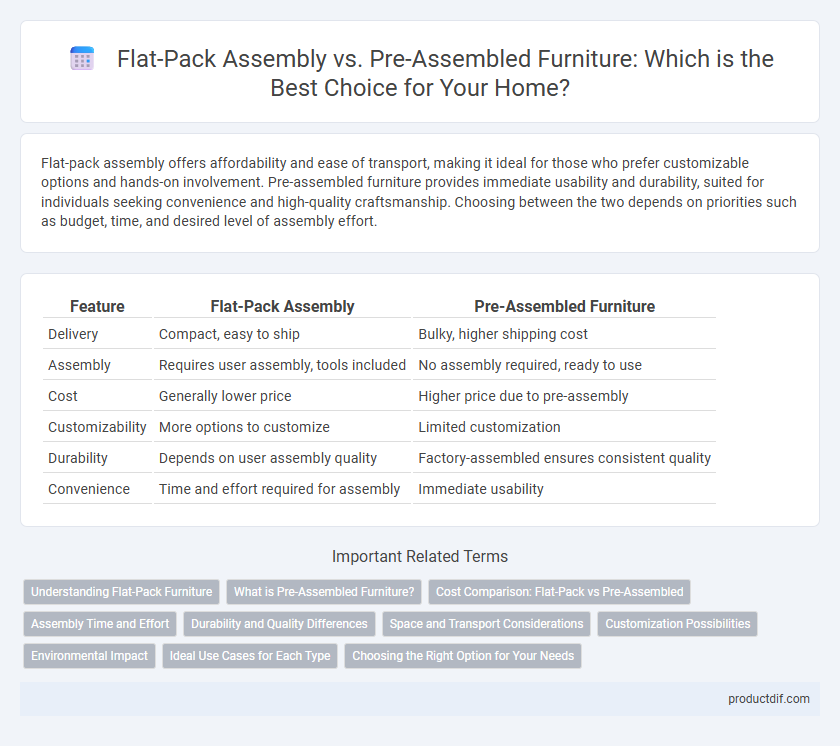Flat-pack assembly offers affordability and ease of transport, making it ideal for those who prefer customizable options and hands-on involvement. Pre-assembled furniture provides immediate usability and durability, suited for individuals seeking convenience and high-quality craftsmanship. Choosing between the two depends on priorities such as budget, time, and desired level of assembly effort.
Table of Comparison
| Feature | Flat-Pack Assembly | Pre-Assembled Furniture |
|---|---|---|
| Delivery | Compact, easy to ship | Bulky, higher shipping cost |
| Assembly | Requires user assembly, tools included | No assembly required, ready to use |
| Cost | Generally lower price | Higher price due to pre-assembly |
| Customizability | More options to customize | Limited customization |
| Durability | Depends on user assembly quality | Factory-assembled ensures consistent quality |
| Convenience | Time and effort required for assembly | Immediate usability |
Understanding Flat-Pack Furniture
Flat-pack furniture consists of components that are packaged separately and require user assembly, offering cost-effective shipping and customizable configurations. This type of furniture often appeals to consumers seeking affordable options with easy transport and space-saving storage before assembly. Understanding flat-pack furniture involves recognizing its reliance on precise instructions and basic tools to achieve stable, functional pieces that match pre-assembled alternatives in style and durability.
What is Pre-Assembled Furniture?
Pre-assembled furniture arrives fully constructed, eliminating the need for tools or additional assembly time. This type of furniture ensures immediate usability and often offers enhanced durability due to factory assembly standards. Pre-assembled pieces are ideal for consumers seeking convenience and high-quality finish without the hassle of putting components together.
Cost Comparison: Flat-Pack vs Pre-Assembled
Flat-pack furniture generally offers a lower upfront cost compared to pre-assembled options due to reduced shipping and storage expenses. Pre-assembled furniture often incurs higher costs reflecting labor, craftsmanship, and immediate usability without assembly time. Consumers seeking budget-friendly solutions typically lean toward flat-pack, while those valuing convenience may prefer pre-assembled despite the premium price.
Assembly Time and Effort
Flat-pack furniture requires significant assembly time and physical effort, often involving numerous screws, panels, and tools, which can extend setup duration to several hours depending on complexity. Pre-assembled furniture eliminates assembly demands, offering immediate usability with no need for tools or instruction interpretation, significantly reducing setup time to zero. Choosing between flat-pack and pre-assembled options depends largely on user convenience preferences and willingness to invest time in assembly processes.
Durability and Quality Differences
Flat-pack furniture often features thinner materials and simpler joinery to facilitate shipping and assembly, which can affect long-term durability compared to pre-assembled furniture that typically uses solid wood and robust construction techniques. Pre-assembled furniture benefits from factory precision and quality control, resulting in stronger joints and enhanced overall quality that withstand daily use over time. Consumers prioritizing longevity and high-quality craftsmanship often prefer pre-assembled options, while flat-pack furniture suits budget-conscious buyers seeking convenience and flexibility.
Space and Transport Considerations
Flat-pack furniture optimizes space efficiency during transport and storage by collapsing into compact, manageable boxes, reducing shipping costs and making it ideal for small urban living environments. Pre-assembled furniture requires more space due to its bulk and shape, increasing transport complexity and expenses, which can be a significant factor in delivery logistics. Choosing between flat-pack and pre-assembled designs hinges on transport constraints and available space both in transit and at the final location.
Customization Possibilities
Flat-pack furniture offers extensive customization possibilities through modular components and adjustable configurations, allowing users to tailor designs to specific space requirements and personal preferences. Pre-assembled furniture typically provides limited customization options, as it is manufactured in fixed dimensions and styles to streamline production. Consumers seeking unique or adaptable furniture solutions benefit more from flat-pack options due to their flexible assembly and design versatility.
Environmental Impact
Flat-pack assembly furniture significantly reduces carbon emissions by minimizing packaging materials and optimizing transportation efficiency due to compact shipping dimensions. Pre-assembled furniture generates higher environmental costs through increased shipping volume and heavier packaging, leading to greater fuel consumption and landfill waste. Choosing flat-pack options supports sustainability by lowering the overall ecological footprint in the furniture supply chain.
Ideal Use Cases for Each Type
Flat-pack assembly furniture is ideal for small living spaces, frequent movers, and DIY enthusiasts who value cost savings and customization options. Pre-assembled furniture suits those seeking convenience, immediate usability, and robust construction, often preferred in professional settings or larger homes where time efficiency is crucial. Choosing between flat-pack and pre-assembled depends on priorities like budget, ease of transport, and assembly skills.
Choosing the Right Option for Your Needs
Flat-pack assembly offers cost savings and customizable options, making it ideal for those who enjoy hands-on projects or have limited budgets. Pre-assembled furniture provides immediate usability and durability, perfect for individuals seeking convenience and time efficiency. Evaluating personal skills, time availability, and space constraints determines the best choice between flat-pack assembly and pre-assembled furniture.
Flat-pack assembly vs Pre-assembled furniture Infographic

 productdif.com
productdif.com